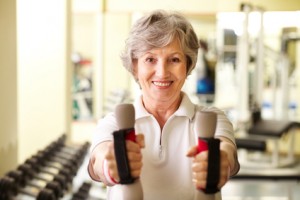As we age, preserving muscle mass is critical to our health and quality of life. Sarcopenia is the gradual loss of muscle mass and strength. Unlike bone loss, which is an unavoidable consequence of aging, sarcopenia is linked to nutritional causes.
People who are age 80 and over – considered the “oldest old” in studies of age-related disease – are among the fastest growing demographic, a demographic expected to more than double in the next century. This age group has been underrepresented in research and scientists are now attempting to correct that oversight.
Loss of Muscle Mass Causes
- Decreased strength
- Exercise intolerance
- Weakness and fatigue
- Poor balance
- Higher risk of falls and injuries
- Metabolism dysfunction
- Climate temperature intolerance
- Higher risk of type 2 diabetes
- Higher risk of dementia
- Premature mortality
A new study published in the Journal of the American Geriatric Society found that these issues can lead to hospitalization and often bed rest – which speeds up the process of sarcopenia in everyone, but especially in the elderly. 
What Causes Sarcopenia?
- Decreased physical activity
- Slower hormone production
- Malnutrition
- Chronic disease
Research from California Pacific Medical Center Research Institute where scientist Peggy Cawthon, PhD, and her team monitored more than 3,000 subjects between 70 and 80 years old for five years shows that improvement is possible.
Their study focused on muscle density – the percentage of fat to lean muscle – and measured participants’ walking speeds and strength of grip.
Cawthon said of their data, “The findings…suggest that interventions, such as physical exercise, that improve physical function could help keep more vulnerable seniors out of the hospital. That would not only reduce disability but it would also reduce the huge economic burden associated with hospitalization of the elderly.”
Nutrition and Muscle Mass
A new study from the International Osteoporosis Foundation (IOF) Nutrition Working Group found that nutrition plays an enormous role in preventing sarcopenia.
University of Geneva Professor of Medicine, Jean-Philippe Bonjour said of their findings, “The most obvious intervention against sarcopenia is exercise in the form of resistance training. However, adequate nutritional intake and an optimal dietary acid-base balance are also very important elements of any strategy to preserve muscle mass and strength during aging.”
Preserving Muscle in 5 Easy Steps
Lean Protein
Made up of amino acids, protein is critical to building and maintaining every muscle in your body. No matter your age, lean proteins are essential to good nutrition and total body health.
Add foods such as boneless/skinless chicken breast, lean beef, fish and seafood, eggs, cottage cheese and beans to your regular diet to give your body the protein it requires.
Vitamin D
Without enough vitamin D, your body does not function properly. Deficiency in this essential vitamin makes you unable to absorb calcium, weakens your immune system and contributes to muscle and bone loss. The most efficient source of vitamin D is the sun. We make it naturally when we spend 15 minutes, three days a week, exposing our face and hands to the sun’s rays. Until you spend some time outside, the vitamin D in your body lies dormant.
Fortified cereals and dairy products, fish and seafood, cheese and eggs are food sources of vitamin D and supplements are helpful during seasons where exposure to the sun is impossible. Talk to your doctor about the best vitamin D dosage for you.
Acid/Alkaline Balance
Too much acid in your body results in inflammation and compromises your immune system. Scientists are finding that heavy intakes of foods high in fat and sugar with too few fruits and vegetables increases cases of acidosis and affects our musculoskeletal health. Finding a balance – opting for lean proteins while including alkaline foods – will protect your body from preventable wear and tear.
Alkaline foods include radishes, broccoli, kale, spinach, apples, bananas, melon, oranges, lemons, almonds, peppers, garlic, cinnamon, curry and ginger.
Folic Acid and B-12
Folic acid is crucial to cell growth and regeneration while vitamin B-12 regulates our metabolism, hormone production, and formation of red blood cells. Both are essential to human health and deficiencies have been linked to bone and muscle loss, dementia, heart disease, chronic pain, cancer and birth defects.
Spinach, asparagus, broccoli, citrus, beans, avocados, seeds and nuts, carrots and squash have an abundance of folic acid while chicken breast, lean beef, eggs, dairy products and seafood will give your system the B-12 it needs.
Low and No Impact Exercise
One reason many elderly do not get regular exercise is fear of injury. For many, falls represent a health decline from which they cannot recover. Finding low or no-impact exercise options for those who suffer from physical disabilities or age-related restrictions is critical to keeping the body strong.
Some exercises to consider are tai chi, water aerobics and chair exercises, which are gaining popularity at senior centers and gyms around the country.
Elderly people who practice tai chi for three years drastically slow the advance of sarcopenia and increase their chances for a longer, healthier life with fewer problems such as heart disease and diabetes.
Taking steps now in regards to exercise and nutrition will make a difference in preserving muscle mass and quality of life no matter your gender, current age or physical fitness level.




